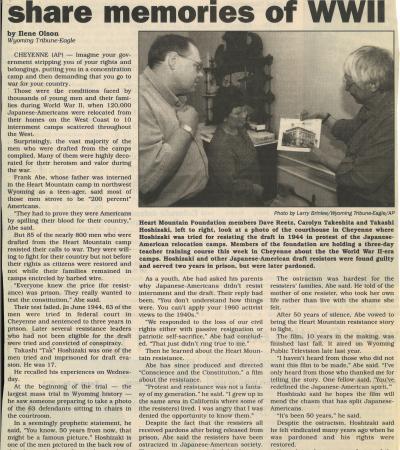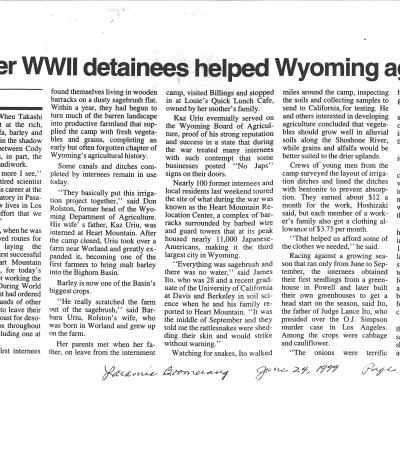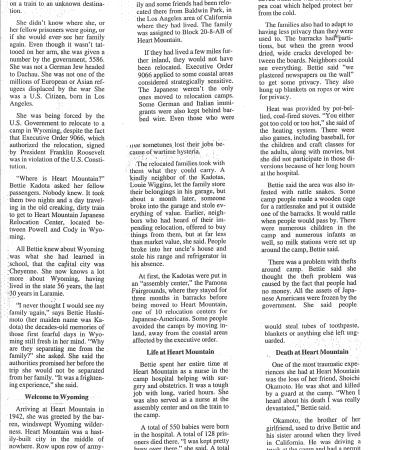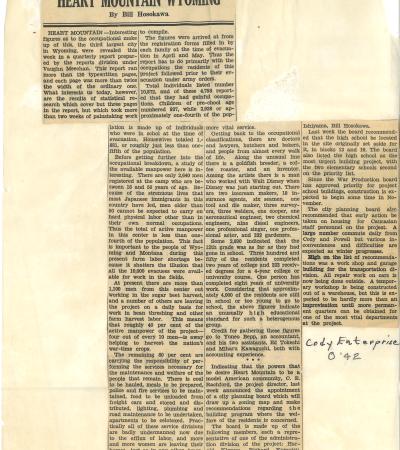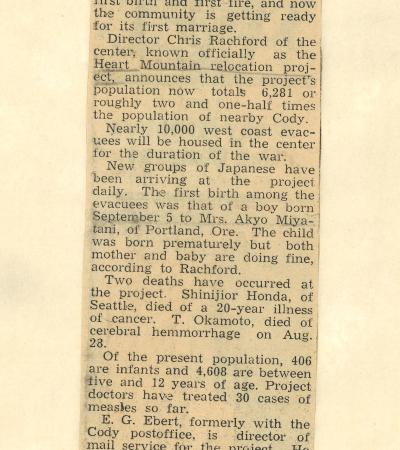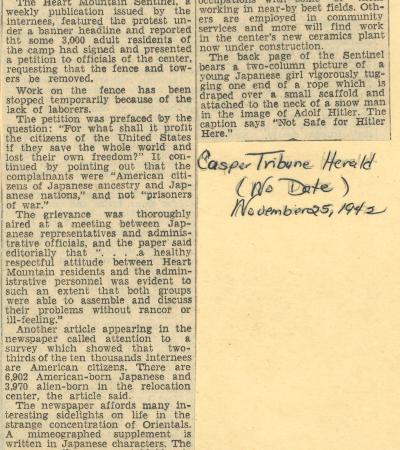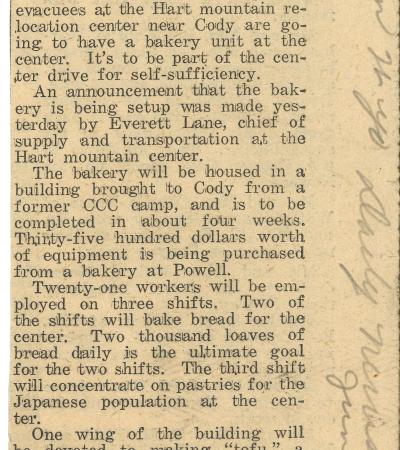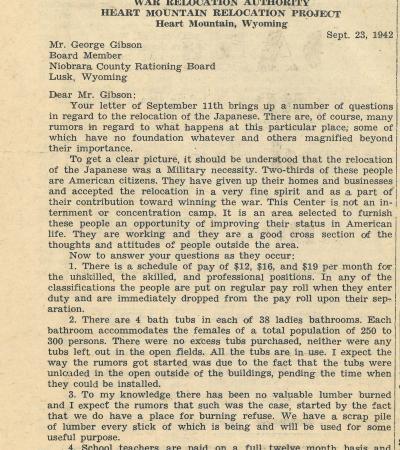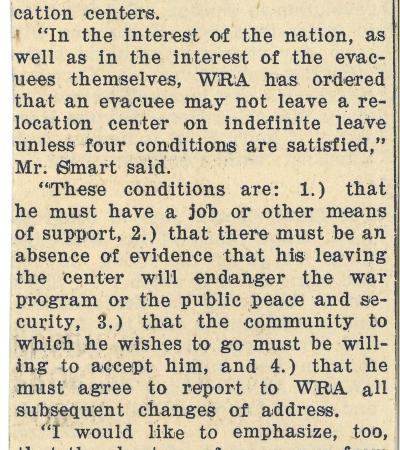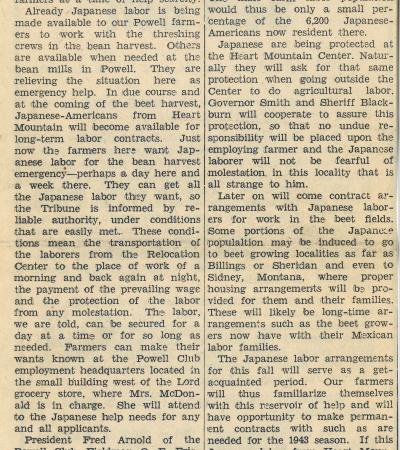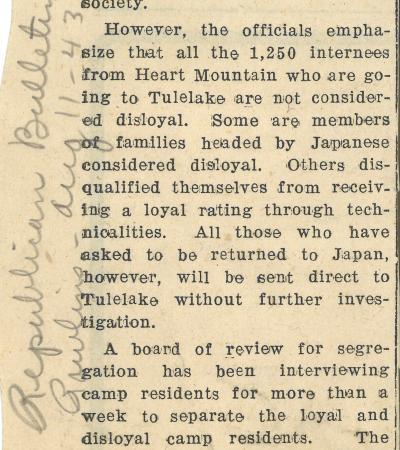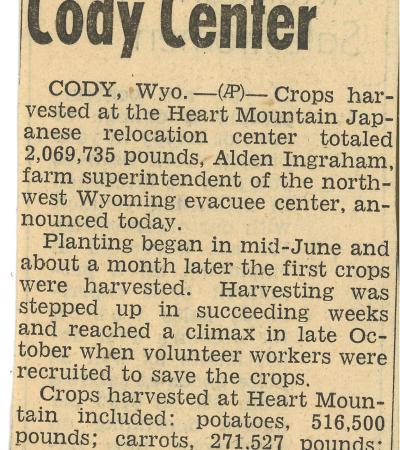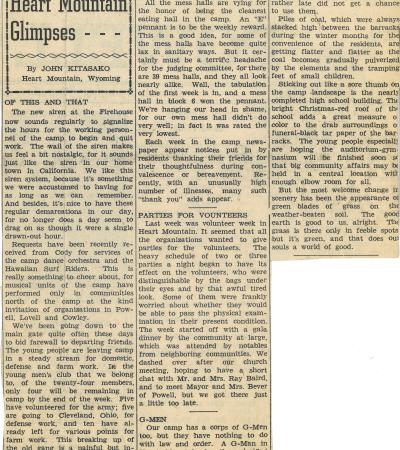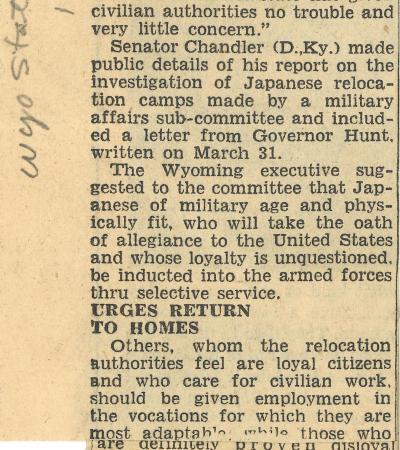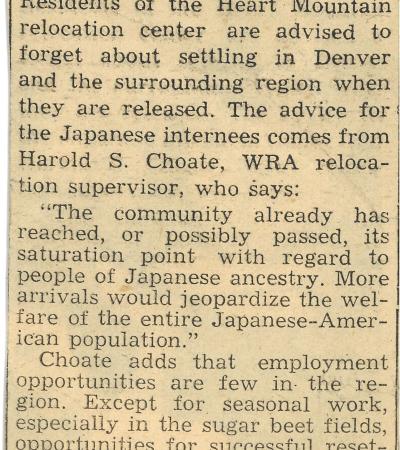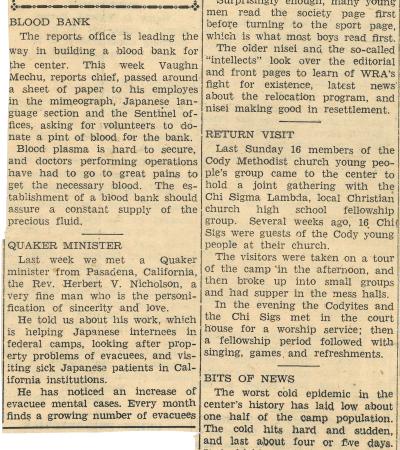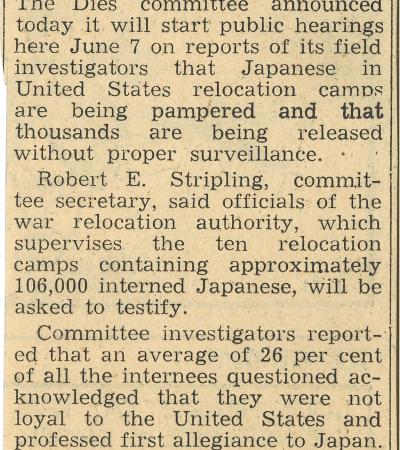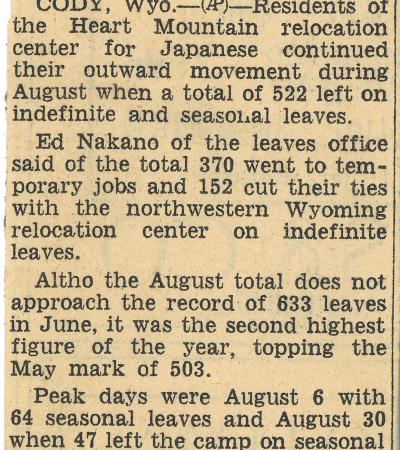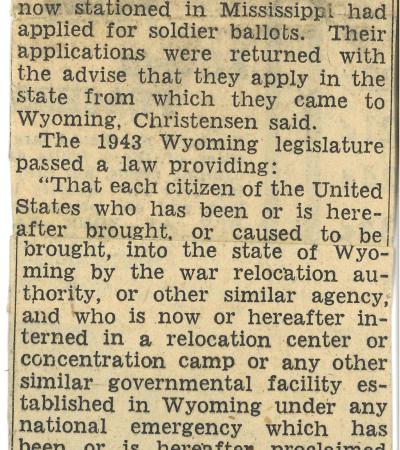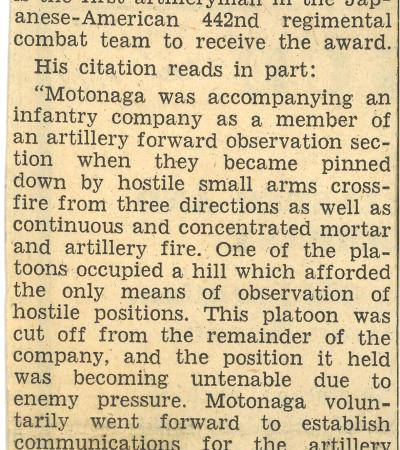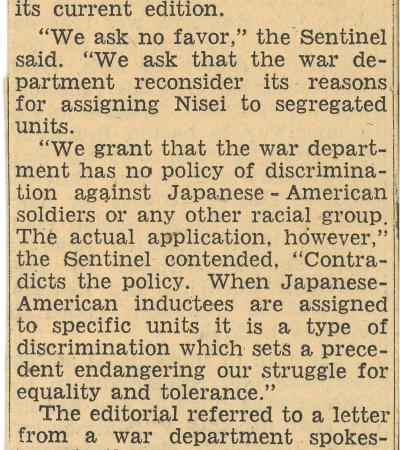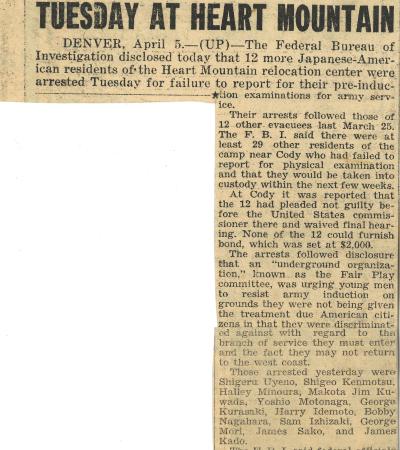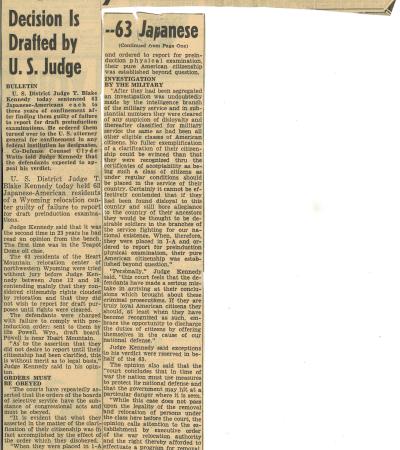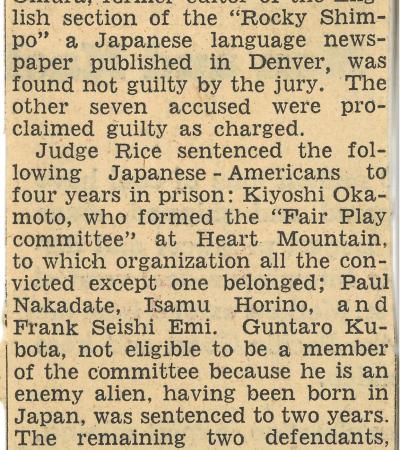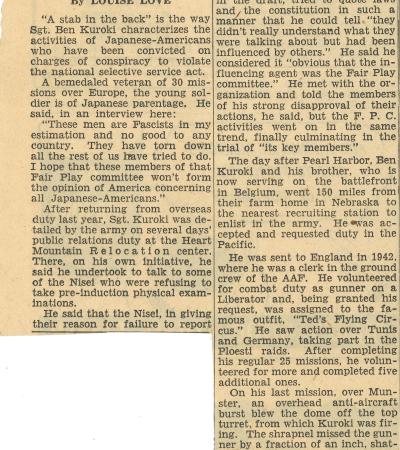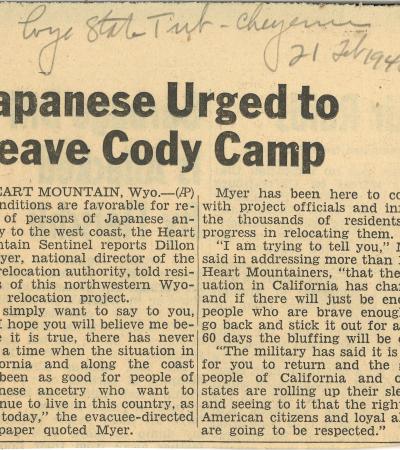This subject file contains newspaper clippings, primarily from Wyoming newspapers. Most of them date to the 1940s, when Heart Mountain Relocation Center was in operation. Many reflect the negative attitudes of the time towards the incarcerated Japanese and Japanese Americans. A few of the articles were written by incarcerees and published in local papers, giving insight into life at Heart Mountain.
"It could happen again, former Japanese American internees say" by Joan Barron, Casper Star-Tribune, June 24, 2001
The article covers the perspective of three Japanese American draft resisters who were incarcerated at Heart Mountain and later convicted and sent federal prison. They returned to Wyoming for a panel discussion in Cheyenne in 2001.
"Japanese-Americans share memories of WWII" by Ilene Olson, Laramie Boomerang, July 26, 2001
The article discusses the experiences of Takashi Hoshizaki, a Japanese American draft resister who had been incarcerated at Heart Mountain and a film project about the resistance, Conscience and the Constitution, that was completed in 2000.
"Former WWII detainees helped Wyoming agriculture" by Michael Milstein, Laramie Boomerang, June 24, 1999
The article highlights some of the contributions made by Japanese American detainees to agriculture in Wyoming during World War II. They include digging canals and ditches used for irrigation and working for $12 a month harvesting crops on farms in the area surrounding Heart Mountain.
"Wyoming prisoner: a stranger in a strange land" by Robert Roten, Laramie Boomerang, September 30, 1998
The article details some of the experiences of Bettie Kadota, a Japanese American incarceree at Heart Mountain. Kadota worked as a nurse at the Heart Mountain Hospital.
"Activities of Heart Mountain Wyoming" by Bill Hosokawa, Cody Enterprise, 1942
The article, written by the editor of the Heart Mountain Sentinel, outlines statistics about the occupations of Heart Mountain incarcerees and announces the appointment of a city planning board, which recommended the construction of Heart Mountain High School as well as two elementary schools.
"A pair of Boy Scouts" by Chris Matthews, Laramie Boomerang, January 16, 2001
The article highlights the friendship that developed between two Boy Scouts, one from Cody and another a Japanese American incarceree at Heart Mountain. The boys grew up to be U.S. Senator Alan Simpson and U.S. Secretary of Transportation, Norm Mineta.
"292 Japanese Arrive in Wyoming At 10,000-Man Relocation Center", Gillette News-Record, August 20, 1942
This article announces the first arrivals to Heart Mountain Relocation Center and discusses the plan for managing the affairs of the community at Heart Mountain.
"Jap Center Is Growing Fast", Laramie Daily Bulletin, September 10, 1942
The article discusses the rapid population increase at Heart Mountain Relocation Center in its first month of operation as incarcerees were brought by train from California.
"Jap Evacuees Object To Barbed Wire Fence", Casper Tribune Herald, November 25, 1942
This article covers the petition that 3,000 Japanese American incarcerees signed requesting that the barbed wire fence and watch-towers surrounding Heart Mountain Relocation Center be removed.
"Heart Mountain Center Houses 11,000 Evacuees"
This article describes conditions and activities at Heart Mountain in the year since its opening.
Various articles about Heart Mountain, April 1943
These articles from Wyoming newspapers cover topics ranging from the controversy over fresh fruits and vegetables that were delivered to Heart Mountain to a pro-American editorial in the Heart Mountain Sentinel.
Various articles about Heart Mountain, May 1943
These articles from Wyoming newspapers give insight to the prejudices faced by the Heart Mountain incarcerees, and the scrutiny placed on Heart Mountain Relocation Center operations by politicians
"Heart Mountain Japs Invite Investigation", Northern Wyoming Daily News, January 27, 1943
This article reports on an editorial in the Heart Mountain Sentinel which was a response to politicians claiming that Heart Mountain incarcerees were being pampered.
"Bakery To Be Built At Jap Center", Northern Wyoming Daily News
This article announces the construction of a bakery at Heart Mountain to meet the daily demand for bread in the mess halls and adds that incarcerees will also begin making tofu, a staple food for many of Japanese descent.
"Some Facts About the Heart Mountain Project", Lusk Herald, October 1, 1942
Heart Mountain Project Director C.E. Rachford writes a letter published in the Lusk Herald newspaper to adddress some of the rumors that have been circulating in Wyoming about conditions and activities at Heart Mountain.
"865 Volunteer Japanese Workers Have Been Recruited", October 9, 1942
This article discusses the Japanese American incarcerees released from Heart Mountain to work harvesting sugar beets in Wyoming and Montana. While farmers were eager to have their labor, the incarcerees faced hostility and suspicion.
"Japanese-Americans To Feed Themselves", Powell Tribune, February 18, 1943
This article discusses plans for incarcerees to farm the land around Heart Mountain to produce more food for themselves. With food rationing underway across the U.S., there was a great deal of pressure on the War Relocation Authority to make Heart Mountain self sufficient.
"Possibility That Sale Of Milk To Japanese In Heart Mountain Area Might Prove Profitable Dairy Market For the Duration", Powell Tribune, July 30, 1942
This article covers the demand for milk at Heart Mountain. While there was much resistance to and suspicion of the people of Japanese descent incarcerated at Heart Mountain, some saw the Relocation Center as a possible source of profit.
"Japanese Labor Now Available At Powell", Powell Tribune, September 10, 1942
This article provides more detail about ways in which the Japanese American incarcerees at Heart Mountain will be made available to labor as farm workers in Powell.
"Disloyal Japs Are Being Segregated", Rawlins Republican Bulletin, August 11, 1943
This article reports on the War Relocation Authority's efforts to segregate Japanese who were deemed loyal to the U.S. from those deemed disloyal. Those who were considered disloyal were sent to Tule Lake Relocation Center in California. In order to make room for the influx of incarcerees at Tule Lake, a number of loyal Tule Lake incarcerees were sent to Heart Mountain.
"Huge Crop Is Harvested at Cody Center", Wyoming State Tribune, 1943
This article details the bountiful harvest at Heart Mountain just one year after it opened. Given the barren land around Heart Mountain, this was accomplished thanks to the agricultural knowledge and hard work of the incarcerees.
"Heart Mountain Glimpses" by John Kitasako, Powell Tribune, April 22, 1943
This article in the Powell Tribune newspaper was written by an incarceree at Heart Mountain. Among the topics covered are cleanliness in the mess halls and the newly constructed high school building.
"Japs Behave At Center, Hunt States", Wyoming State Tribune, May 15, 1943
This article highlights both the paternalistic attitude and discrimination faced by the people of Japanese descent incarcerated at Heart Mountain. While the Governor of Wyoming was encouraging them to return to their original homes after incarceration, politicians in California were arguing that the incarcerees would not be welcomed back in California.
"Japs Warned Out Of Denver Area", Laramie Daily Bulletin, August 11, 1943
This article is illustrative of the challenges faced by Japanese American incarcerees who wanted to relocate out of Heart Mountain. The War Relocation Authority actively discouraged them from making plans to settle in Denver and the surrounding region.
"Activities of Heart Mountain Wyoming" by Bill Hosokawa, Cody Enterprise, October 7, 1943
This article, written by the editor of the Heart Mountain Sentinel newspaper and published in the Cody newspaper provides a glimpse into life at Heart Mountain.
"Heart Mountain Glimpses" by John Kitasako, Powell Tribune, October 30, 1943
This article in the Powell Tribune newspaper was written by an incarceree at Heart Mountain. It gives insight into every day life at Heart Mountain, including the arrival of 400 people from Tule Lake Relocation Center.
"Heart Mountain Glimpses" by John Kitasako, Powell Tribune, December 16, 1943
This article in the Powell Tribune was written by an incarceree at Heart Mountain. Among the topics covered are the opening of a blood bank and the visit by a Quaker minister from California.
"Dies Will Start Hearing on Jap Camps on June 7", 1943
This article covers the Dies Committee in the U.S. House of Representatives which held a series of hearings into how the War Relocation Authority was managing its internment camps, including Heart Mountain.
"522 Japanese Leave Center", Cheyenne State Tribune, October 8, 1943
This article give insight into some of the jobs done by Heart Mountain incarcerees outside the internment camp.
"Students at Relocation Center Denied University Scholarships", Laramie Boomerang, May 25, 1943
This article illustrates the discrimination faced by even the best students at Heart Mountain High School.
"Jap Evacuees Cannot Vote", Wyoming State Tribune, September 22, 1944
This article describes the rejection of ballot applications from two soldiers who enlisted from Heart Mountain. The Wyoming legislature passed a law that prohibited incarcerees from voting in any election held in the state.
"Nisei Soldier Gets Silver Star", Billings Gazette, November 5, 1944
This article announces the awarding of a silver star for gallantry in action in Italy to Japanese American Sergeant Mac M. Motonaga. Motonaga's mother was incarcerated at Heart Mountain.
"Regard Us as Americans, Japanese Say", Wyoming State Tribune, April 3, 1944
This article discusses the Army's segregation of Japanese American soldiers into special units, with quotes from the Heart Mountain Sentinel newspaper.
"Japanese Girl From Heart Mountain Enlists in WAACS", July 1, 1943
This article covers the acceptance by a Japanese American woman into the Women's Auxiliary Army Corps. She had been incarcerated at Heart Mountain with her family.
"Twelve More Nisei Arrested Tuesday At Heart Mountain", April 6, 1944
This article announces that a group of Japanese American incarcerees has been arrested for failure to report for their pre-induction examinations for army service.
"Largest Mass Trial Ever Conducted In Wyoming", Powell Tribune, June 22, 1944
This article covers the trial of 63 Japanese American incarcerees from Heart Mountain. They were accused of draft evasion and failure to report for their pre-induction physical examinations.
"63 Japanese-Americans Guilty of Draft Violations", Wyoming State Tribune, June 26, 1944
This article gives insight into the thinking of U.S. District Judge T. Blake Kennedy in the sentencing of 63 Japanese Americans who had been incarcerated at Heart Mountain.
"Japanese Arrested by FBI on Draft Counts", Wyoming State Tribune, July 21, 1944
This article covers the arrests of several Japanese Americans accused of being members of the Heart Mountain Fair Play Committee.
"Seven Nisei Will Appeal", Wyoming State Tribune, November 2, 1944
This article describes the sentencing of Japanese Americans from Heart Mountain after they were found guilty of a conspiracy to violate the national selective service act. Their attorney vowed to appeal the case to a higher court.
"Nisei War Hero Hits Japanese-Americans Who Fight the Draft", Wyoming State Tribune, November 3, 1944
This article illustrates the tension within the Japanese American community incarcerated at Heart Mountain. There were some, like members of the Fair Play Committee, who resisted the draft. Others, like Sergeant Ben Kuroki, who visited Heart Mountain, took pride in their service in the U.S. military and spoke out against the resisters.
"Order Received To Close Japanese Camp Near Here", Cody Enterprise, December 20, 1944
This article covers two announcements. First, that the war department has revoked the ban which prohibited all people of Japanese ancestry from living in the Pacific coastal states. Second, that Heart Mountain Relocation Center will be closed.
"Japanese Urged to Leave Cody Camp", Wyoming State Tribune, February 21, 1945
This article covers the remarks by the national director of the War Relocation Authority to incarcerees at Heart Mountain. Despite the difficult conditions at Heart Mountain, some incarcerees were reluctant to return to California and the West Coast, rightly suspecting they would face hostilities upon their return.
"Heart Mountain Relocation Center To Close By December 31", Cody Enterprise, February 21, 1945
This article discusses plans at Heart Mountain, in light of the U.S. government decision to close the camp. Plans include stopping farming operations and livestock activities as well as closing the schools.
"Heart Mountain detainees felt weight of western prejudices", by Ed Marston, Cody Enterprise, April 15, 1985
This article discusses the prejudices Heart Mountain incarcerees faced from local communities in Wyoming and across the West. It highlights the Japanese and Japanese Americans' struggles, while enduring hostility, forced labor and confinement, while also contributing to local economies and volunteering for military service.

